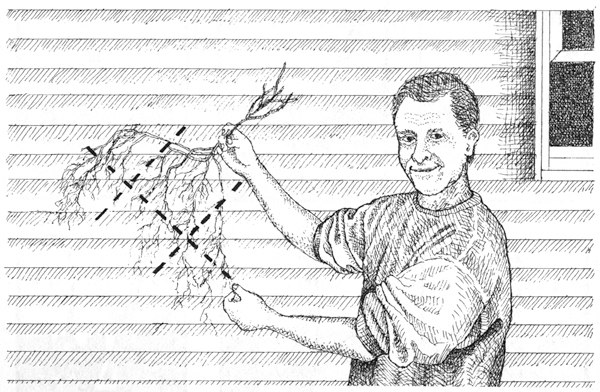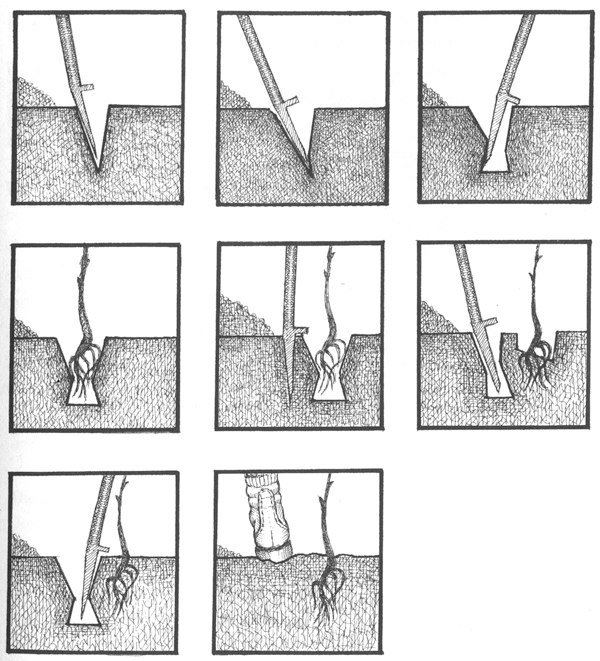Common Sense Forestry

Sensible woodlot management
A woods can be managed to maximize recreation potential, or increase wildlife for hunting, or maximize timber. This guidebook assumes you’d like to optimize your woodlot’s timber potential in a sustainable fashion. Small-time woodlots with selective harvesting are a lot of work yielding little money, but with applied intelligence they can produce wonderfully rich and productive forests. This detailed manual will teach you intelligent woodlot management. What the author learned over 35 years is that you the forester should do as little as possible — just enough to encourage the woods to do as much as possible.
07/25/13Excerpt
Here are eight steps for planting a seedling with a spud.
*
A typical oak seedling before trimming. Its roots are too long for spud planting.
*
Some time ago, I surmised that I could establish an exciting mixed-species forest simply by planting as many seedlings of different varieties as I could fit in a given plot of land. As the stand matured, I could decide which trees to keep and which to cull, creating the mixture of trees I wanted. The stand would form an early canopy and the trees would side shade each other, meaning I'd never have to prune. Natural selection would favor the best trees to survive. They would become perfectly shaped veneer logs with little lateral branching. …By any reasonable standard of investment analysis, planting in this fashion is fiscal insanity. Yet this experimental plot promises to develop into a wonderful forest better than any other scheme I've witnessed for planting seedlings. It will require virtually no maintenance beyond thinning, which means it will flourish even if I do nothing.
*
A site I had prepared for walnuts suddenly was inundated by giant ragweed, which grew to twelve feet in a couple of weeks, totally smothering all my seeded walnuts and oaks. Elsewhere I disced ash seeds between the rows of a walnut plantation. The ashes never appeared, but an influx of Queen Anne's lace dominated the ground. Along a hedgerow of cedars I planted years ago, little cedars germinate in one particular spot and nowhere else. There must be something special about this spot (a "site-specific" condition, as ecologists and foresters say when they can't explain such a peculiarity). Similarly, on property I own miles away from my main farm, I see new white spruces popping up next to their parents, while I seem to be incapable of making them germinate on my farm. The pH is not low enough at my farm, and conifers prefer acid soil.
*
I have never seen or heard of a seedling that resulted in too many trees. Experts suggest that about fifteen thousand seedlings an acre is a good number, which means about three seedlings per square foot. I suggest that you plant whatever seeds you have.
*
After having planted two fields next to a forest where squirrels stole every single nut in two successive years, I decided that I can live without walnut trees.
*
Taping a fork as shown will strengthen the branches. Later, you can remove one branch and the other will become the new leader.
*
You should also remember a suggestion I made earlier: Always cut the most inferior tree before cutting your best. You should upgrade your forest so as to maintain large, well-formed trees for future harvests. I urge you to be personally involved in deciding which trees are to be cut.
*
Mark your harvest trees carefully. Most commonly trees to be harvested are marked with a paint gun by you or a forester. It is best to mark two spots on the tree: one at eye level to be seen by the logger and a second spot at the base to assure that only designated trees are harvested.
*
An environmentally friendly method of getting logs to the logging roads is a system of winches and cables. Extracting logs by suspending them from cables does less damage to the forest than the use of heavy equipment. German foresters don't allow skitters to move about in the woods, so all logs are dragged by cable to a logging road.
Common Sense Forestry Hans W. Morsbach 2002, 240 pages $28












